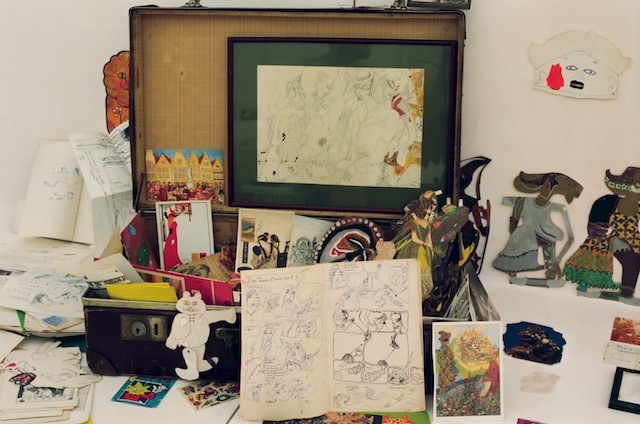Museum of Modern Art, New York through 22 January
Kai Althoff has transformed a suite of galleries at MoMA into a fever dream of neurosis and autobiography. White fabric tents the space, which has been opened to form one long room. A sweet perfume the artist concocted infuses it. Music he composed plays as background noise. Things Althoff made, or selected, are placed everywhere. Paintings and drawings dating from his childhood and more recent work hang on freestanding walls, lean on shelves or are wrapped in brown paper and stacked as if in storage. Vitrines are filled with items such as perfume bottles, a feather boa, dolls and lace. The contents of torn upholstered furniture spill onto the floor near a diorama of a charred Middle European village.
Obvious precedents for this mise-en-scène include Renaissance wunderkammern, the work of Joseph Beuys and Expressionist film sets. Where these suggest an intellectual history, Althoff’s paintings and drawings nod to homoerotic dysfunction in twentieth-century Germany. Their subject matter ranges from androgynous boys to Hasidic Jews, from upper-class, Wilhelmine German students to a bright-eyed country boy perhaps on his way to becoming a fascist tough. Much of this work is rendered in attenuated lines, seductive, jewellike colours and a flattened pictorial space that recalls Emil Nolde, André Thomkins and Egon Schiele, to name but a few.
Style, content and sources are less clues to the meaning of the work, however, than they are annotations or entries in what must be understood as an autobiography told by and through the material production and collected souvenirs of Althoff’s mind, here jumbled together physically in the way that experience is often jumbled in memory: compressed, contemporaneous and associative. It is just stuff until either the artist or his audience makes connections between it. A painting inscribed with ‘Ich bins’ (it’s me), which stands near the entrance to the show, drives home the point.
One cannot see everything here. There is too much, and the placement of works on high shelves or in detritus-strewn bays precludes direct viewing. But it is impossible to ‘see’ everything about anything or anyone, after all. Perhaps the Hasidim who strive to sense God’s Time in the quotidian are apt doppelgängers for Althoff, or for anyone who yearns to catch a whiff of the divine, however one experiences it. Tellingly, a painting of Doubting Thomas is placed next to one of a Hasidic family. In an untitled drawing from 2012–14, a Hasidic man dances in reverie. According to DovBer Naiditch, a Lubavitch rabbi who is friends with the artist and who wrote for the exhibition catalogue, the dancing man’s pose suggests that he senses a Messianic Time beyond time, much as the wounds Thomas touches are keys to the prophetic.
Althoff ’s is clearly an exhibitionist, fragile self. In an interview published in the catalogue he answers questions taken as obtuse with puerile vexation. And in its excess, the show can seem like the overflow of a mind that cannot stand its own static. What viewers take from the show depends on how ready they are to listen to that noise, and to the noise in their own minds.
From the January & February 2017 issue of ArtReview
